> OUR PROJECTS
The Italian & International Patrons of the Arts in the Vatican Museums group is an association which supports the restoration and conservation of the vast, unique and priceless art collection contained in the Vatican museums, with a special mission to make this artistic historical and spiritual legacy accessible to everyone.
Over the years, the Italian & International Patrons have contributed to important Restoration & Art Access projects carried out in the Vatican Museums. Below an overview of these:
RESTORATION OF ETRUSCAN GOLD FIBULA AND RING
March 2022
These golden jewels are part of a magnificent set that includes personal ornaments and pottery made of precious materials. They accompanied the main burial, which related to a woman of rank, and astonished those who entered and discovered this monumental tomb in April 1836. These discoveries constituted one of the most important testimonies of the Etruscan Orientalizing period. It consists of a fibula and a ring decorated with granulation, geometric and schematic motifs, such as meanders and the solar disk.
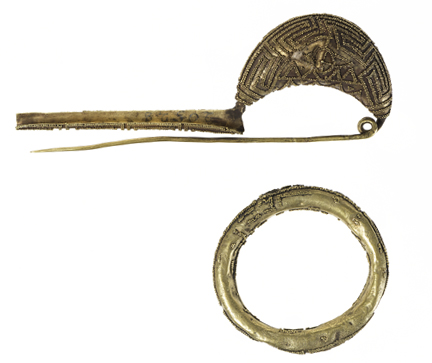
> read about this project
RESTORATION OF RAPHAEL TAPESTRY OF ANANIA WITH TWO SIDE TAPESTRIES OF
CLEMENT VI
January 2022
The last Raphael tapestry in the Vatican Museums that needs restoration is the Death of Anania. It arrived in Rome before the end of 1521. In December of the same year, this precious and valuable work was pawned, with the others from the same series, to a German banker named John Welser to pay off the large debts that Pope Leo X accumulated during his pontificate. The tapestry depicts the passage of the Acts of the Apostles that narrates the death of Anania.
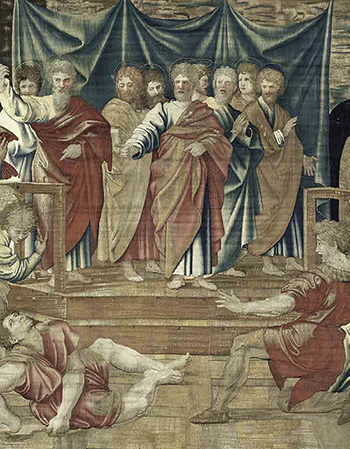
> read about this project
RESTORATION OF THE APOLLO DEL BELVEDERE
June 2021
The Patrons of the Arts in the Vatican Museums have been selected for the 2021 Bank of America Art Conservation Project grant to help finance the restoration of the Apollo del Belvedere, one of the most admired among the ancient statues of Rome.
The Bank of America Art Conservation Project provides grants to museums to conserve historically or culturally significant works of art that are in danger of degeneration, including works that have been designated as national treasures.
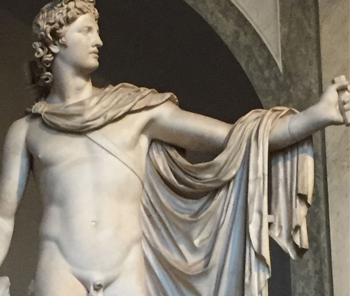
> read about this project
ANIMA MUNDI ETHNOLOGICAL MUSEUM
January 2021
Anima Mundi is the Ethnological section of the Vatican Museums. The 80,000 objects in the collection display a selection of works representing the artistic, cultural, and spiritual traditions and testimonies of non-European peoples. To name a few of the many works, the collection includes totems, shields, feather headdresses, and painted eyes peeking out behind wooden masks. These objects and the cultures that they represent are the real protagonists of the Ethnological section. The mission of this museum is to feature the diversity of beauty, preserve it from the threats of extinction, and share with all a world of inclusion, creativity, and heritage.
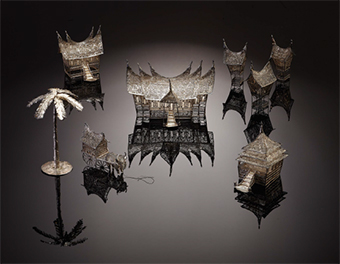
> read about this project
SAINT MARGARET OF ANTIOCH AND STORIES OF HER LIFE
October 2020
Painted on a large vertical ogival panel which recalls the shape of a tabernacle, and framed by a Gothic arch, a young Saint Margaret of Antioch, also known by the name of Saint Marina, stands like a column statue, proud and magnificent. Draped in a precious cloak of green damask embroidered with a motif of gold palmettes, a diadem placed on her golden hair, in one hand she holds a slim Crucifix, while with the other she welcomes the figure on her right, the kneeling donor, who is smaller in scale. At her feet lies the conquered dragon, symbolising evil and related to an episode from her life. According to the hagiographers, the dragon devoured the saint who saved herself by slashing its belly open with her Crucifix. The tradition of this extraordinary event gave Margaret the ability to grant wishes to those who invoke her.
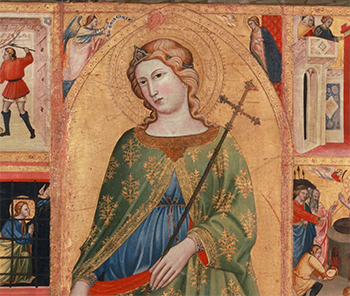
> read about this project
RESTORATION OF THE BRAMANTE COURTYARD
May 2019
At the request of Pope Julius II, Architect Donato Bramante began his great project in 1504 to construct a theatrical space with a dramatic façade and staircase upon the available terrain within the villa on Vatican Hill. His design was intended to integrate nature, provide access to the most beloved antique statues, and offer a serene walk throughout the rest of the palace. Over time, modifications altered Bramante’s original design, such as when the medieval palace next to St. Peter’s needed to connect to the Villa Belvedere atop the hill.
Today, the Courtyard’s four façades are still among those that have remained quintessential in defining renaissance architecture, and are at last being restored according to techniques used at the time of their conception and construction. The most distinctive section the Courtyard, the Wall of the Nicchione, is part of the northern façade of the Bramante Courtyard. Its construction commenced under the building direction of Pirro Ligorio at the request of Pope Pius IV (Medici 1560-65), and received its large hemispherical niche during the papacy of Clement IX (Albani, 1700-1721). It is here where the large, 4-meter high bronze Pinecone, originally located in the Campus Martiusand later in the atrium of the old St. Peter’s Basilica, stately resides in its niche, providing the alternative namesake, The Pinecone Courtyard.
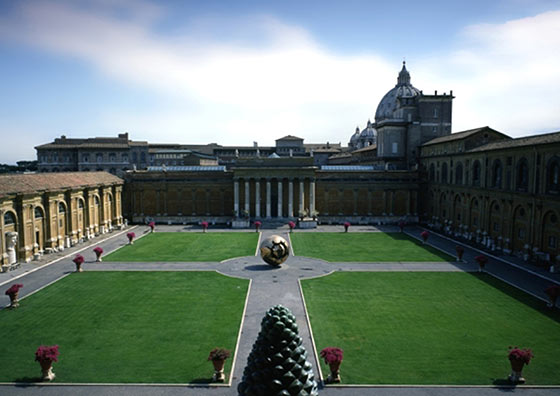
> read about this project
RESTORATION OF GOLD NECKLACES FROM THE REGOLINI-GALASSI EXCAVATION
March 2019
In the Necropolis of Sorbo in Caere (today the town Cerveteri), Fr. Alessandro Regolini and General Vincenzo Galassi discovered in 1836 one of the richest and most representative Etruscan tombs dating from 675 to 650 B.C. The artifacts found are now exhibited in Hall II of the Gregorian Etruscan Museum, in the Vatican Museums.
The collection is one of the most complete testimonies to the “Orientalizing” phase in ancient history, a cultural phenomenon that involved Etruria and the entire Mediterranean basin in an extended circulation of goods and knowledge from the East thanks to the activity of the Phoenicians and Greeks.
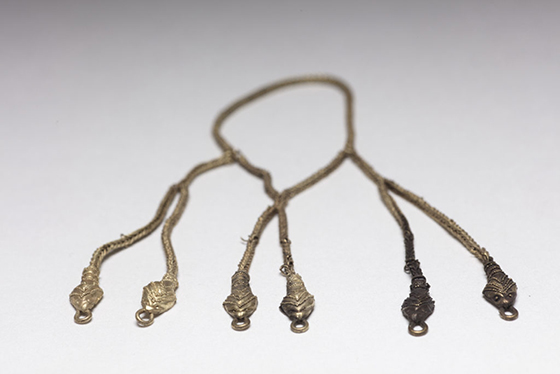
> read about this project
PREVIATI'S CLAIRE DE LUNE RESTORATION
February 2019
The painting Clair de Lune, completed in 1909, is the most recognized image of the Notturno painting series made by Previati. The series features three other panels depicting Wind, Dance, and Harmony.
Inspired by Beethoven’s Sonate au Clair de Lune, the four panels were conceived for the Milanese villa of Alberto Grubicy, a patron of the artist. The paintings were to be placed in the music room setup for Grubicy’s daughter, who studied piano. In 1920 the cycle, including another version of the Nocturne, was donated by Grubicy to his friend D’Annunzio, who then placed the work in the Vittoriale degli Italiani at the Gardone Riviera.
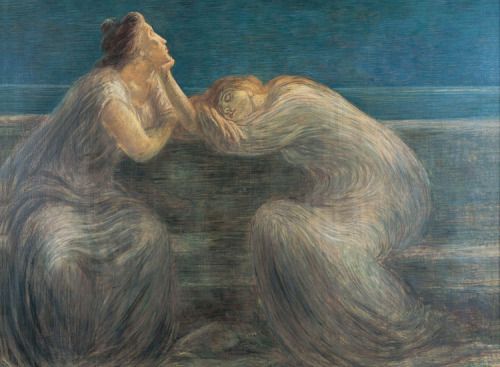
> read about this project
MULTISENSORY HILDEGARDA GARDEN IN THE PAPAL GARDENS OF CASTEL GANDOLFO
January 2019
The Hildegarda flowerbed is being developed in order to offer a multi-sensorial tour of the Papal Gardens to visually impaired, blind, deaf blind, deaf, mentally disabled visitors so that they may be able to experience benefit from a place so unique and so rich in spirituality.
The project also provides the opportunity to analyze and identify the area not only through a botanical or historical point of view, but also through the representtion of the most interesting and characteristic species of vegetation in the Pontifical Gardens.
> read about this project
RESTORATION OF AN ANCIENT ROMAN SARCOPHAGUS WITH MARINE PROCESSION
August 2018
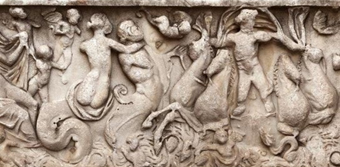 This sarcophagus dates back to the 2nd century and its frontal part is adorned with a group of marine gods and subjects. In the centre, Poseidon, the absolute sovereign of the oceans, emerges from the sea’s wild waves with his chariot, dominating the scene. On his side Tristons, Nereids and “pistrici” (in Greek mythology the pistrici were mosters. The lower part of their bodies resempled a snake). On the extreme left, Poseidon’s wife appears, Amphitrite – recognizable from the veil on her head and from the typical hand gesture. Numerous exuberant Erotes are depicted while flying through the sea foam, talking with the Nereids or playing with the dolphins; animating almost the entire scene that is occupied by an embossed decoration. This sarcophagus dates back to the 2nd century and its frontal part is adorned with a group of marine gods and subjects. In the centre, Poseidon, the absolute sovereign of the oceans, emerges from the sea’s wild waves with his chariot, dominating the scene. On his side Tristons, Nereids and “pistrici” (in Greek mythology the pistrici were mosters. The lower part of their bodies resempled a snake). On the extreme left, Poseidon’s wife appears, Amphitrite – recognizable from the veil on her head and from the typical hand gesture. Numerous exuberant Erotes are depicted while flying through the sea foam, talking with the Nereids or playing with the dolphins; animating almost the entire scene that is occupied by an embossed decoration.
> read about this project
RESTORATION OF 18 GOLD GLASS ARTIFACTS FROM THE VATICAN MUSEUMS' GOLD GLASS COLLECTION
April 2018
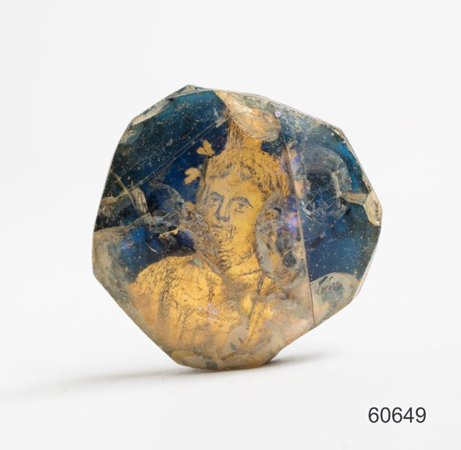 Thanks to one of our most active and generous member, Olessia Kantor, our Chapter had the the opportunity to help restore Thanks to one of our most active and generous member, Olessia Kantor, our Chapter had the the opportunity to help restore
Eighteen gold glass artifacts from the golden glass collection of the Vatican Museums. The golden glass collection of the Vatican Museums is amongst the most remarkable worldwide; and these pieces belong to the most precious glass productions of the late ancient ages. A refined technique allowed the creation of glass pottery, mostly plates and bowls, which were decorated with representations made in gold leaf that were set into two layers of glass.
> read about this project
VATICAN MUSEUMS INNOVATIVE AND DIDACTIC ACTIVITY FOR BOTH DEAF AND HEARING CHILDREN
January 2018
 The Vatican Museums, in collaboration with the Istituto Statale Sordi di Roma and “Italia Creativa” Association, designed an innovative and inclusive educational activity, which can be simultaneously experienced by both deaf and hearing children. The visits will be organized in different Vatican Museum areas using special installations, B-Sense platforms, capable of converting music and sound into vibrations, offering all participants both the hearing and deaf, the opportunity to listen and feel melodies through the body. The Vatican Museums, in collaboration with the Istituto Statale Sordi di Roma and “Italia Creativa” Association, designed an innovative and inclusive educational activity, which can be simultaneously experienced by both deaf and hearing children. The visits will be organized in different Vatican Museum areas using special installations, B-Sense platforms, capable of converting music and sound into vibrations, offering all participants both the hearing and deaf, the opportunity to listen and feel melodies through the body.
> read about this project
DROP OF WATER: CIRCLE OF LIFE BY KENGIRO AZUMA
January 2017
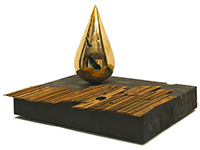 This artwork was created by Kengiro Azuma in 2011, on the occasion of the exhibition dedicated to the 60th year of priesthood of Pope Benedict XVI. As he was invited to participate to this very important event, the artist decided to pay homage to the Pope by creating this masterpiece. Goccia d’acqua, Ciclo della Vita (Drop of Water the circle of Life) embodies all the special characteristics that make this artist’s production so grand. Moreover, the artwork is marked by meticulous poetic attention to the material and by a symbolic rendering of the subject portrayed. This artwork was created by Kengiro Azuma in 2011, on the occasion of the exhibition dedicated to the 60th year of priesthood of Pope Benedict XVI. As he was invited to participate to this very important event, the artist decided to pay homage to the Pope by creating this masterpiece. Goccia d’acqua, Ciclo della Vita (Drop of Water the circle of Life) embodies all the special characteristics that make this artist’s production so grand. Moreover, the artwork is marked by meticulous poetic attention to the material and by a symbolic rendering of the subject portrayed.
> read about this project
STUDENTS LEARN WHY IT IS IMPORTANT FOR THE BLIND TO SEE ART IN THE VATICAN MUSEUMS
December 2016
article by Amy Gallant Sullivan, Dr. David A. Sullivan - essays by Patrick Harris & Angelina Kemmett - translations by Ludovica Mazzitelli
-sm.jpg) Thinking back to your formative years, do you recall one moment that shaped you and your perspective, a turning point, which was the catalyst of your growth from child to adult? How would you inspire and motivate young people to reach beyond themselves for knowledge and experience? Thinking back to your formative years, do you recall one moment that shaped you and your perspective, a turning point, which was the catalyst of your growth from child to adult? How would you inspire and motivate young people to reach beyond themselves for knowledge and experience?
“I am truly blessed to go to Matignon High School, where such an 'experience' is possible.” So said Angelina Kemmett, a sophomore at Matignon High School, who with Junior Patrick Harris, recently had a private guided tour through the Vatican Museums with a special focus on the multi-sensory exhibit for the visually impaired. Both students won an essay contest at Matignon, an independent and co-educational Catholic High School, in Cambridge, Massachusetts, addressing the question, “Why is it important for the visually impaired to “see” the art in the Vatican Museums?” Eight judges from around the world selected the two winners, with the award a trip with two chaperones to the Vatican Museums.
> read about this project
TOUCHING ART INTERACTIVE EDUCATIONAL DISPLAYS IN THE VATICAN MUSEUMS
March 2016

As the Italian & International Patrons promote projects that focus on making art accessible to all, particularly those with disabilities who otherwise would not be able to participate, we have pledged to support the Touching Art Interactive Educational Displays in the Vatican Museums.
To allow everyone to experience the collection in the Pio Christian Museum, even the blind and visually impaired, the curators have designed a special tactile display that provides resin casts of five chosen works, accompanied by an explanation. Note that the Pio Christian Museum houses the most important collection of Early Christian sculpture in the world.
> read about this project
AN EYE ON THE VATICAN MUSEUMS: SEEING THE MIRACLE OF ART
March 2016
One of our International Patrons, Dr. David A. Sullivan, of Harvard Medical School and Schepens Eye Research Institute, who has been a Patron since our inception, recently proposed a wonderful idea that will help grow our Chapter and develop relationships with Catholic Universities and Schools.
> read about this project
PINOCCHIO!
February 2016 - Vatican Museums' Contemporary Section
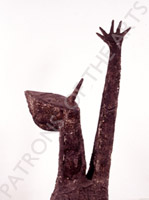
We cannot tell a lie, we were charmed by the idea of restoring Pinocchio!
Venturi’s Pinocchio arrived in the Vatican Collection in 2004, as a gift from the artist’s granddaughter, Lucy Fiaschi. The entire surface of the work was covered in dust. Some areas were damaged and altered by dust and oxidation. The restoration process included a complete makeover and cleaning with scientific research, dust suction, micro-dust suction and the reparation of cracks.
> read about this project
LASER FOR CLEANING WORKS OF ART
January 2016
Thanks to the support from one of our gracious Patrons, Olessia Kantor, along with the California Chapter, we subsidized the purchase of an Eos Syntesis laser. The Eos Syntesis is the first laser system set up for laser cleaning that allows restorers to tune the pulse duration by nanoseconds to hundredths of a nanosecond to microseconds.
> read about this project
MICHELANGELO’S MADONNA DI BRUGES FOR THE VISUALLY IMPAIRED UNVEILED IN THE VATICAN MUSUEMS
June 2015 - Vatican Museums' Pinacoteca
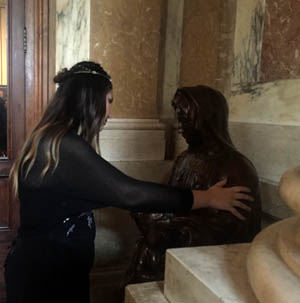 On Saturday, 13 June 2015, the Italian and International Patrons of the Arts joined together for a special soirée in the Vatican Museums for the inauguration and unveiling of Michelangelo’s Madonna di Bruges in the Pinacoteca. Michelangelo's Madonna di Bruges, created and formed from the original casts of Casa Caravaggio, was dedicated to the tour for the visually impaired in the Vatican Museums. A poignant and unique experience, all Museum visitors will now be able to touch this masterpiece created by the genius of Michelangelo and recognize the face of the Virgin Mary and her child Jesus. On Saturday, 13 June 2015, the Italian and International Patrons of the Arts joined together for a special soirée in the Vatican Museums for the inauguration and unveiling of Michelangelo’s Madonna di Bruges in the Pinacoteca. Michelangelo's Madonna di Bruges, created and formed from the original casts of Casa Caravaggio, was dedicated to the tour for the visually impaired in the Vatican Museums. A poignant and unique experience, all Museum visitors will now be able to touch this masterpiece created by the genius of Michelangelo and recognize the face of the Virgin Mary and her child Jesus.
Guests from Italy and around the world, including the United States, France, Monaco, Finland, Poland, Algeria, Turkey, Switzerland, Australia and Denmark witnessed a splendid occasion embraced by the voices of angels and the miracle of art.
This extraordinary and memorable evening, organized by the Italian and International Patrons Leaders, Sabrina Zappia and Amy Gallant Sullivan, was opened by the Eminent Cardinal Lajolo with the unveiling of the Madonna di Bruges. Father Mark Haydu, International Director of the Patrons of the Arts in the Vatican Musuems introduced and thanked the Fonderia Marinelli in Florence, together with Ronald and Susan Welborn, Patrons from Texas, who donated this exquisite and historically important sculpture.
> read about this project
MANUSCRIPTS
March 2015 - Vatican Musuems
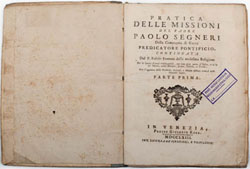
A generous Patron supported the restoration of a collection of manuscripts, including a volume recounting the trip of the English ambassador Lord Macartney who, appointed by King George III, traveled to the Chinese imperial court of Emperor Qian Long as well as countries of the tartars.
This is the first Italian translation published in Venice and is followed by a second edition in Florence. The document material was comprised of the memories of Lord Maccauley and of Sir Erasmus Gower, who were placed at the head of the expedition. The illustrations were completed by Sir Joseph Banks, President of the Royal Society.
> read about this project
PIETRO MELANDRI'S MODELS OF THE VATICAN MUSEUMS ENTRANCE
January 2015 - Vatican Museums
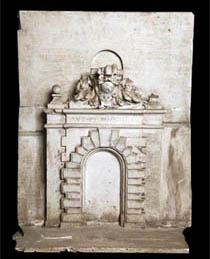 Pietro Melandri was a famous Italian painter, decorator, designer and ceramist, student of the School of Arts and Crafts of Faenza. In 1921 his ceramics were displayed at the Biennale in Rome and lately, in 1925, at the L’Expo des Arts Decoratives in Paris. In the 1930s he also collaborated with the papal architect and engineer Giovanni Momo for the structural renovation of the Vatican Museum. Melandri continued to work until his death in Faenza in 1976. Pietro Melandri was a famous Italian painter, decorator, designer and ceramist, student of the School of Arts and Crafts of Faenza. In 1921 his ceramics were displayed at the Biennale in Rome and lately, in 1925, at the L’Expo des Arts Decoratives in Paris. In the 1930s he also collaborated with the papal architect and engineer Giovanni Momo for the structural renovation of the Vatican Museum. Melandri continued to work until his death in Faenza in 1976.
These two plasters models, created by PietroMelandri, represent the Main Entrance of the Vatican Museums, whichwas renovated by the papal architect and engineer Giuseppe Momo by will of Pope Pius XI at the beginningof 1930s. At present, these are in poor condition, due to the dust that has accumulated on the surface. Many fractures and ...
> read about this project
MULTISENSORY ITINERARY IN THE VATICAN GARDENS
May 2014 - Vatican Gardens
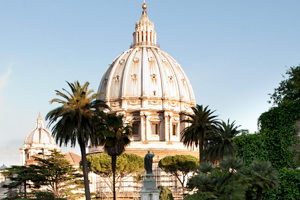
WHO IS IT FOR?
Visually impaired, blind, deaf blind, deaf, mentally disabled and visually impaired visitors interested in experiencing such a multi-sensorial journey. People with physical disabilities can also access the flowerbed of Hildegard.
INTRODUCTION
The idea of a multisensory guided tour of the Vatican Gardens arises from the need to respond to a repeatedly expressed desire from blind, visually impaired and deaf-blind individuals asking to benefit from a place so unique and so rich in spirituality.
> read about this project
VATICAN MUSEUM MASTERPIECES SPEAK TO THE HEARING IMPAIRED
Art with a Different Tune
June 2013 - Vatican Museums
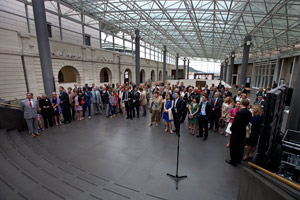
> read about this event and see the photos
VATICAN MUSEUM MASTERPIECES UNVEILED FOR THE BLIND
The Beauty of Art for those who see differently
June 2012 - Vatican Museums
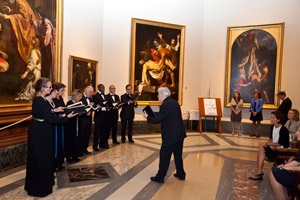
> read about this event and see the photos
Italian & International Patrons of the Arts in the Vatican Museums
Non Profit Organization
Via Francesco Cherubini 4 00135 Roma
t +39.0633252960 f +39 0696708632
Codice Fiscale 97793910585
vaticanpatrons.it
info@vaticanpatrons.it
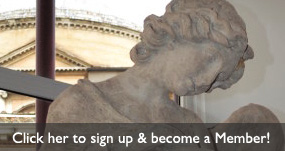
|